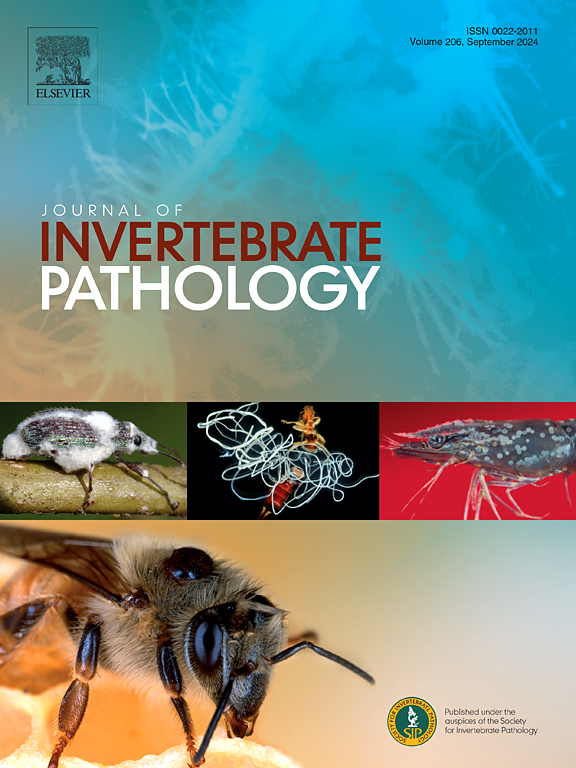引入或扩增的昆虫病原体对非目标捕食者和拟寄生虫的潜在负面影响
IF 2.4
3区 生物学
Q1 ZOOLOGY
引用次数: 0
摘要
本文综述了引入的或增强的昆虫病原体(病毒、细菌、真菌和线虫)与自然存在的节肢动物天敌(捕食者和拟寄生虫)在害虫综合管理计划中的复杂相互作用。人们日益认识到昆虫病原体是化学农药的可持续替代品,化学农药对生态系统和人类健康有有害影响,在可行的生物防治替代品容易获得之前,昆虫病原体往往被禁止使用。因此,作为虫害管理的一个基本方面的生物防治必须扩大,以弥补这一差距并保障充足的粮食生产。这种扩展需要彻底了解与生物防治方法相关的潜在负面影响,即使这种影响通常预期不如化学防治所产生的影响那么严重。这篇综述综合了目前关于昆虫病原感染如何影响捕食者和拟寄生虫种群的知识,重点关注不同病原体群体的感染、驱避和吸引效应,特别是那些以受感染宿主为食或在受感染宿主内发育的病原体。研究表明,从耐受性到潜在危害,对捕食者的影响各不相同,一些捕食者甚至有助于昆虫病原体的病毒传播,潜在的负面影响值得考虑。天敌的联合应用可以加强害虫控制,但精确的时间、浓度和配方对于最大限度地提高效益和减少对有益生物的伤害至关重要。虽然昆虫病原体可以影响某些有益昆虫,但其益处大于非目标影响。所有群体的共同点是需要进一步的研究,特别是在现实条件下的长期实地研究,以充分了解它们在复杂生态系统中的相互作用。通过了解这些相互作用,我们可以制定优化的害虫控制策略,以促进生物多样性,增强农业、栖息地管理和保护的可持续性。本文章由计算机程序翻译,如有差异,请以英文原文为准。

Potential negative effects of introduced or augmented entomopathogens on non-target predators and parasitoids
This review examines the complex interactions between introduced or augmented entomopathogens (viruses, bacteria, fungi, and nematodes) and naturally occurring arthropod natural enemies (predators and parasitoids) within Integrated Pest Management programs. Entomopathogens are increasingly recognized as sustainable alternatives to chemical pesticides, which have detrimental effects on ecosystems and human health and are frequently banned before viable biocontrol alternatives are readily available. Consequently, biological control, a fundamental aspect of pest management, must expand to bridge this gap and safeguard adequate food production. This expansion necessitates a thorough understanding of potential negative impacts associated with biocontrol methods, even though such effects are generally anticipated to be less severe than those stemming from chemical control. The review synthesizes current knowledge on how entomopathogenic infections influence predator and parasitoid populations, focusing on infection, repellency, and attractancy effects across different pathogen groups, particularly concerning those feeding on or developing within infected hosts. Studies show varied impacts on predators, from tolerance to potential harm, with some predators even contributing to viral dispersal of entomopathogens, potential negative impacts warrant consideration. Combined applications of natural enemies can enhance pest control, but precise timing, concentration and formulations are crucial to maximize benefits and minimize harm to beneficial organisms. While entomopathogens can affect certain beneficial insects, the benefits outweigh the non-target impacts. A common thread across all groups is the need for further research, particularly long-term field studies under realistic conditions, to fully understand their interactions within complex ecosystems. By understanding these interactions, we can develop optimized pest control strategies that promote biodiversity and enhance the sustainability of agriculture, habitat management, and conservation.
求助全文
通过发布文献求助,成功后即可免费获取论文全文。
去求助
来源期刊
CiteScore
6.10
自引率
5.90%
发文量
94
审稿时长
1 months
期刊介绍:
The Journal of Invertebrate Pathology presents original research articles and notes on the induction and pathogenesis of diseases of invertebrates, including the suppression of diseases in beneficial species, and the use of diseases in controlling undesirable species. In addition, the journal publishes the results of physiological, morphological, genetic, immunological and ecological studies as related to the etiologic agents of diseases of invertebrates.
The Journal of Invertebrate Pathology is the adopted journal of the Society for Invertebrate Pathology, and is available to SIP members at a special reduced price.

 求助内容:
求助内容: 应助结果提醒方式:
应助结果提醒方式:


